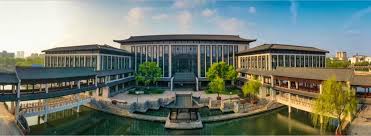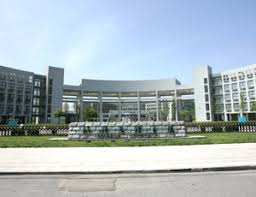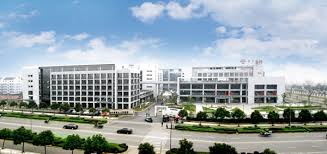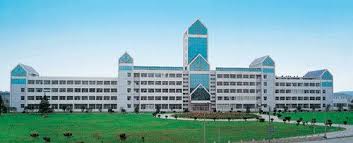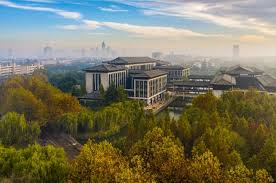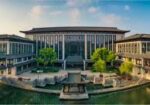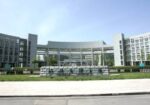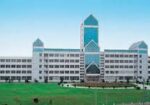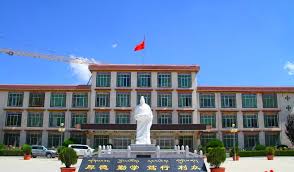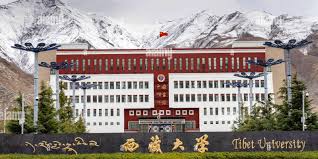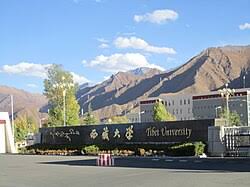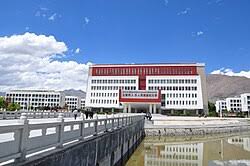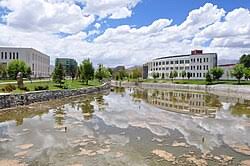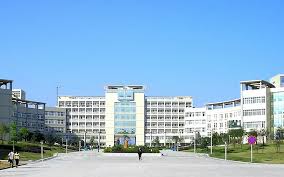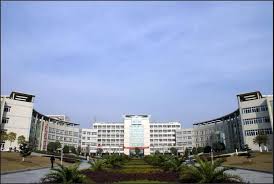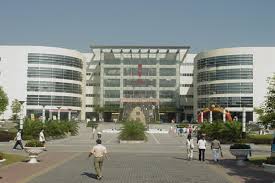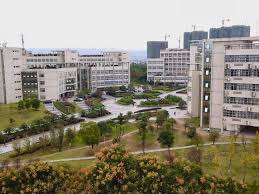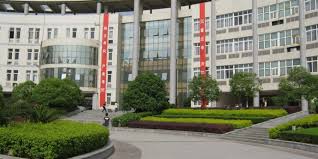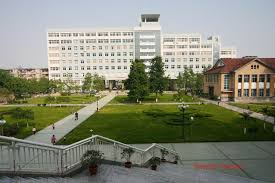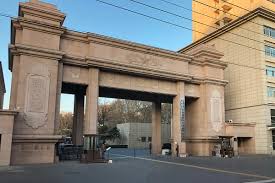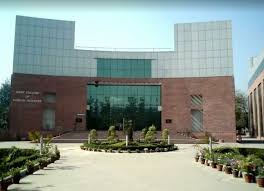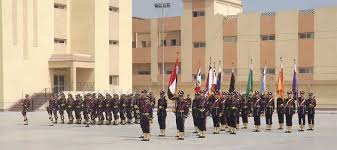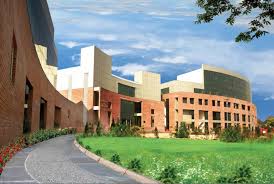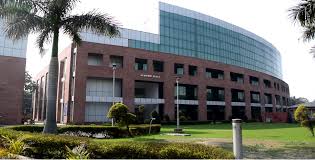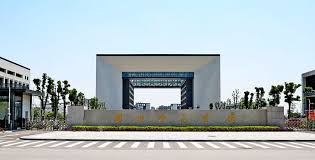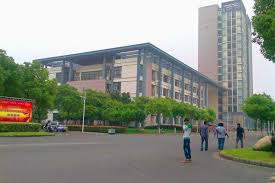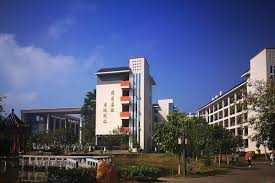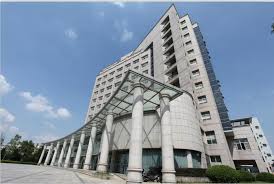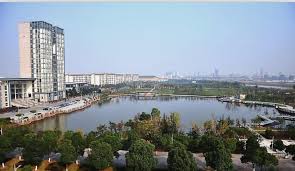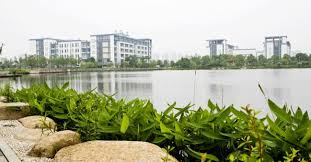Shaoxing University Medical School “Shaoxing University” is a People’s Republic of China Ministry of Education-approved comprehensive multidisciplinary university. The history of the university started with the establishment of Shankuai Primary Normal School in 1909. Lu Xun, a Chinese literary great and a native of Shaoxing, was the Supervisor (Principal) of the school at one time, establishing a significant historical link between the university and contemporary Chinese culture.
About Shaoxing University Medical School
Over the years, the institution has developed immensely through strategic mergers. In 1996, Shaoxing Teachers’ College and Shaoxing College of Higher Education were merged to create Shaoxing University. Subsequently, in 2000, Shaoxing Health School, Shangyu Normal School, and Shaoxing Secondary Technical School for Urban-Rural Development Constructors were incorporated into the university, further enhancing its academic programs and resources.
It passed the undergraduate teaching level test in 2005 conducted by the Ministry of Education and received a B rating. In 2013, it reached a milestone when the Academic Degrees Committee of the State Council recognized it as one of the institutions conferring master’s degrees in China.
Shaoxing University Medical School – Table of Contents
- About
- Advantages
- Ranking
- Departments And Course Duration
- Facilities And Infrastructure
- Required Documents
- Eligibility Criteria
- Admission Process
- Benefits
- Privileges And Benefits for Indian Students
- FAQ’s
Located in Shaoxing, a city recognized as one of the first batch of National Famous Historical and Cultural Cities, the university runs on four campuses — Fengzejiang Campus (East and West), Nanshan Campus, Lanting Campus, and Shangyu Campus — covering a total area of 1,487.29 mu (approximately 99.2 hectares). It has a total building area of 625,500 square meters.
The teaching and research equipment of the university is worth 447 million yuan, and its richly-equipped library contains 1.8695 million books, 1.1632 million e-books, 1.8472 million Chinese and foreign-language e-journals, and 49 professional databases.
Scholarship-wise, Shaoxing University has 16 schools, one independent college (Yuanpei College), and one university-affiliated hospital. It provides 63 undergraduate courses in nine disciplines, three of which are national characteristic subjects, 23 provincial key or characteristic subjects, and seven provincial first-class subjects.

Shaoxing University Medical School Accreditations, Affiliations, Recognitions
The university also has several provincial-level experimental teaching demonstration centers and off-campus practice bases. It admits students from 26 provinces, autonomous regions, and centrally-administered municipalities, as well as Hong Kong, Macao, Taiwan, and over 40 foreign countries, and has a lively and multinational student body of approximately 15,000 full-time students.
Given its well-placed emphasis on application-oriented education, the university has received accolades as a Zhejiang Demonstration University, a National College English Teaching Reform Demonstration University, and a Pilot University for Building Application-Oriented Institutions in teaching in classrooms.
The university also boasts the Lanting School of Calligraphy, the first Chinese calligraphy education base for international students in Zhejiang, and a calligraphy creation base certified by the Zhejiang Calligraphers Association. It has its Student Innovation Park as one of the first groups of Zhejiang Province University Students’ Entrepreneurship Demonstration Bases, fostering innovation and entrepreneurship. Its graduates boast an employment rate of more than 95% for five years consecutively, and employer satisfaction rankings topping the list in the province annually.
Shaoxing University is also strong in scientific research and innovation. It has seven master’s programs in first-level academic disciplines, six professional master’s programs, and six provincial first-class disciplines. Its engineering discipline is one of the top 1% ESI international disciplines globally.
It has several provincial key laboratories, a National Excellent Traditional Chinese Culture (Calligraphy) Inheritance Base, key philosophy and social science research bases, as well as collaborative innovation centers. Over the last five years, it has conducted 621 research projects at the ministerial and provincial levels, of which 187 are national-level projects, and has been awarded 28 scientific and technological achievement awards.
The university boasts a high-quality faculty of more than 1,600 members, among whom are over 1,100 teachers — close to 500 with senior professional titles and close to 500 with Ph.D.s. There are among them national and provincial award-winning teachers, special government allowance holders, Qianjiang Scholars, as well as leaders in all kinds of provincial talent programs.
Internationalization is a fundamental cornerstone of Shaoxing University’s strategy. It has established cooperative partnerships with more than 60 universities in 22 countries and regions, including the United States, Canada, the United Kingdom, Australia, Russia, and Japan. The university also actively propagates Chinese language and culture overseas through such activities as the Lanting Academy of Calligraphy set up in nine foreign nations.
And guided by Xi Jinping Thought on Socialism with Chinese Characteristics for a New Era, Shaoxing University is staying true to its motto of “cultivating moral integrity and pursuing the truth”. With a three-step development strategy, it is moving towards becoming a high-level, application-oriented university with unique features, equating strong academic standards with cultural heritage, creativity, and a global perspective.
Advantages of Studying in Shaoxing University Medical School
Strong Academics and Practical Training:
High-Quality Education:
Shaoxing University Medical School is known for its rigorous academic curriculum and commitment to providing students with a strong foundation in medical knowledge.
Practical Skills Focus:
The school emphasizes hands-on training, ensuring students develop the necessary practical skills for their future careers.
Experienced Faculty:
Students benefit from instruction by experienced and knowledgeable faculty members.
Well-Equipped Facilities:
The university provides students with access to modern facilities, including well-stocked libraries and research laboratories.
International Recognition and Opportunities:
Globally Recognized Programs:
Shaoxing University Medical School’s MBBS programs are recognized by various international bodies, including the.
Global Exposure:
The university encourages students to participate in international exchange programs and research opportunities, broadening their horizons and preparing them for a globalized world.
Career Prospects:
Graduates of the medical school are well-prepared for careers in various healthcare settings, including hospitals, clinics, and research institutions.
Supportive Environment:
Friendly Atmosphere:
Shaoxing University is known for its friendly and welcoming environment, which can be particularly helpful for international students adjusting to a new culture.
Language Support:
The university provides language support services to help international students overcome any communication barriers.
Campus Life:
Shaoxing University offers a vibrant campus life with various extracurricular activities and student organizations, creating a well-rounded educational experience.
Latest Notifications:
Shaoxing University Medical School – Ranking
The roots of Shaoxing University can be traced back to 1909 when the Shaoxing Shanhui Primary Normal School was established, initiating modern teacher education in the area. In 1915, the Zhejiang No. 5 Normal School was founded, further cementing Shaoxing’s position as an educational center. By 1923, the Shaoxing No. 5 Normal School was incorporated into the Zhejiang No. 5 Middle School, combining teacher training with general secondary education.
On the eve of the victory of the Anti-Japanese War, the institution saw a resurgence as the Shaoxing Simple Normal School was rebuilt in the picturesque Kuaiji Mountain region, representing resilience and a fresh pledge to education in an era of turmoil. The school was renamed Shaoxing County Normal School in 1948, fitting its identity more staunchly within the local community.
Major overhauls arrived in August 1951, when the Zhejiang Provincial Department of Culture and Education formally sanctioned the Zhejiang Shaoxing Primary Normal School’s formation. This was complemented in September 1956 by the creation of the Shaoxing Secondary Normal School, widening its scope to educate teachers at more than one level. In 1970, the institution was renamed the Shaoxing Regional Normal School, as it increased in stature to extend beyond county limits.
There was a significant change in April 1978, when it was promoted to a junior college, admitting students for higher teacher training. On August 8, 1980, the college reached another milestone when the State Council sanctioned the founding of Shaoxing Teachers College, finally elevating its academic status.
The subsequent years witnessed further diversification. In December 1984, Shaoxing Polytechnic was founded to meet the technical and vocational education requirements. By March 1986, a cooperative education model was initiated, which was jointly run by Shaoxing Polytechnic, the Shaoxing Branch of Provincial TV University, and the Shaoxing Workers University, combining several streams of higher education.
In October 1993, the Shaoxing Municipal Party Committee and the Municipal Government planned for a more extensive institution and decided to construct Shaoxing University, based on the merged strengths of Shaoxing Teachers College and Shaoxing Polytechnic. The vision came into being in August 1995, when the two bodies formally merged. Lastly, in April of 1996, after approval by the Ministry of Education, Shaoxing University of Arts and Sciences was officially instituted, setting the stage for what is now a top multidisciplinary university in Zhejiang Province.
Departments And Course Duration in Shaoxing University Medical School
MBBS (Bachelor of Medicine, Bachelor of Surgery) at Shaoxing University
- The Medical School at Shaoxing University is located on the Nanshan Campus and offers the MBBS program, known in the university’s context as “Bachelor of Medicine.”
- It is a five-year undergraduate medical degree taught in Chinese, requiring completion of secondary education and an entrance examination. The program is not open to foreign students.
- Note: In the broader context of China’s medical education system, an MBBS (or equivalent clinical medicine) program typically lasts six years, including one year of compulsory internship. It also often includes instruction in Chinese language and may integrate aspects like Traditional Chinese Medicine into the curriculum.
Departments & Schools at Shaoxing University
Shaoxing University’s academic structure includes a wide spectrum of departments, especially within its School of Medicine, as well as many other faculties.
-
School of Medicine includes:
-
- Clinical Medicine
- Basic Medicine
- Beauty Medicine
- Chinese Medicine
-
Nursing Science
Key other schools and departments across the university include:
- Literature & History (Chinese Language & Literature, Journalism, History)
- Political & Law (Political and Ideological Education, Law)
- Foreign Language (English, Business English)
- Physical Education
- Arts (Music, Fine Arts)
- Mathematics & Computer Science (Mathematics, Computer Science)
- Physics & Electronics Science (Physics, Electronic Information)
- Chemistry & Chemical Engineering (Chemistry, Applied Chemistry)
- Educational Science & Technology (Educational Science, Psychology, Education Technology)
- Engineering (Architectural Engineering, Mechanical Engineering, Electric Engineering, Mining Engineering)
- Business (Finance & Accounting, Business Administration, Tourist Management)
- Agriculture, and Continuing Education
Latest Updates:
Facilities And Infrastructure at Shaoxing University Medical School
Shaoxing University’s Medical School (originally part of Zhejiang Shaoxing Health School) has evolved into a well-equipped institution offering comprehensive teaching, practical training, and research capabilities.
1. Teaching & Research Facilities — Medical Experimental Center
- Comprises four laboratory buildings covering approximately 16,872 m², housing:
- Basic Medicine Center: anatomy, histology, embryology, pathology, physiology, biochemistry, pharmacology, microbiology; includes specimen collections, teaching models, virtual dissection platforms, and digital morphology systems.
- Clinical Skills Training Center: realistic hospital-like environments with simulation wards, ICUs, operating rooms, OSCE stations, and equipment such as simulators (e.g., childbirth manikins), ventilators, and surgical tables.
- Virtual Simulation Center: virtual anatomy, physiology, molecular biology laboratories, teaching platforms, PBL scenarios, and an animal experimentation simulation center. Over 85 virtual modules support blended digital learning.
- Research Platforms: Eight specialized sub-platforms spanning molecular biology, cell biology, anatomy, immunology, animal behavior, electrophysiology, etc., totaling ~2,500 m² with equipment worth roughly 20 million yuan. Instruments include mass spectrometers, small-animal MRI, flow cytometers, PCR systems, and more.
These facilities elevate the medical school as a provincial excellence center for experimental teaching and innovation.
2. Clinical & Practice Training Bases
- The medical school has a robust clinical network, including one directly-affiliated hospital, eight teaching hospitals, five internship hospitals, six community health centers, a mental health center, and a disease control center.
- It also hosts national-level and provincial-level standardized residency training bases, ensuring broad exposure to real-world medical training.
3. Student Facilities: Campus-Wide Infrastructure
While specific Medical School accommodations aren’t detailed online, Shaoxing University broadly provides:
- Hostels & Accommodation: Multiple dorms with facilities such as air conditioning, personal balconies, and varying occupancy types based on student feedback.
- Library & Study Spaces: Libraries with extended hours, including late-night access and reading rooms (in most similar colleges).
- Canteens: On-campus dining halls serving breakfast, lunch, and dinner across Nanshan and Hexi campuses.
- Health Services: Campus clinics and health centers accessible to students across multiple locations.
- Tech & Connectivity: Free campus Wi-Fi and dormitory internet (e.g., free CMCC-EDU wireless, optional wired networks with annual fees).
- Extras: On-campus ATMs, supermarkets, and courier services for student convenience.
Official site For Shaoxing University Medical School: Click Here
Required Documents For Admission in Shaoxing University Medical School
- Application Form
- Passport size photographs
- Marksheets of class 11 and 12 from the respective board of education
- School leaving certificate
- Scanned copy of a valid passport including image
- Certificates of extracurricular activities if any
- All the documents should be attested and notarized from the relevant authorities
Eligibility Criteria For Admission in Shaoxing University Medical School
- Age: The student should be at least 17 years old
- Academic Qualification: Students must have completed their secondary education or equivalent from a recognized board with Physics, Chemistry, and Biology as mandatory subjects.
- Language Proficiency: International students must be proficient in the Chinese language as it is the language of instruction for the MBBS program.
- Entrance Exam: Students must clear the entrance exam conducted by the respective university.
- Health Checkup: International students must pass a medical examination to ensure they are fit to pursue MBBS studies
Admission Process For Shaoxing University Medical School
- Online Application: Fill out the application form and submit the required documents online.
- Fee Payment: Once the university reviews and approves the application, pay the required fees.
- Immigration Process: The university initiates the immigration process and issues an invitation letter after receiving the ministry order.
- Visa Approval: The visa approval process takes around 30 days.
- Travel to China: After receiving the student visa, students can finalize their travel plans and prepare for departure.
Get more details about the colleges in China: Click Here
Benefits of Studying in Shaoxing University Medical School
Here are some compelling benefits of studying at Shaoxing University Medical School, gathered from what we know about the university and the general strengths of Chinese medical education. While specific testimonials for Shaoxing’s medical school are limited, these advantages—many supported by broader sources—paint a clear picture of its value:
Institutional Strength & Academic Environment
- Rich historical and cultural backdrop: Located in Shaoxing, recognized as one of China’s first national historical and cultural cities, the university offers a serene yet prestigious setting combining tradition with academic rigor.
- Modern facilities and strong infrastructure: Extensive library holdings, state-of-the-art laboratories, and well-developed teaching resources support both medical and broader academic pursuits.
Medical Education in China: Broader Advantages Applied to Shaoxing
- Globally recognized degrees: Chinese medical programs are generally accredited by global authorities such as the WHO, NMC (India), GMC (UK), and USMLE bodies, enabling graduates to pursue licensing internationally after completing required exams.
- Affordable tuition and cost of living: Compared to Western countries, medical education in China is notably less expensive, with relatively low living costs, making it financially accessible for many international students.
- Excellent clinical exposure and infrastructure: Many Chinese medical schools—including Shaoxing’s—are linked to high-grade affiliated hospitals, offering students practical training and hands-on clinical experience.
- English-medium instruction: Chinese universities offer MBBS programs in English, lowering language barriers for international students, while also giving the opportunity to learn Mandarin for better clinical and cultural integration.
- Multicultural and supportive campus life: Study environments in China often feature international student communities and multicultural activities, fostering inclusivity and cultural exchange—Shaoxing University in particular hosts students from more than 40 countries.
- Safety and student-friendly environment: Chinese campuses are known for secure environments, efficient transport, and well-established student services, making daily life manageable and safe for foreign students.
Real Student Insights
While these cover general trends, international student experiences can vary.
“China has … top equipment, ease of access towards learning materials and helpful educators.
“I’m a Sri Lankan … they’ve all said they had no problem getting jobs in other countries including countries like the UK and Australia.
Some caution, however, about language barriers and recognition challenges in certain countries:
“The language might be a problem … especially to practice abroad.
Studying at Shaoxing University Medical School blends historical charm, solid academic infrastructure, and modern international benefits. The global accreditation, hands-on training, and supportive atmosphere offer a rich environment for aspiring medical professionals.
Privileges And Benefits for Indian Students in Shaoxing University Medical School
1. Internationally Recognized Degrees
- Degrees from Chinese medical institutions are recognized by key bodies including the World Health Organization (WHO), India’s National Medical Commission (NMC), and others like USMLE authorities—opening paths to practice or further studies in India and abroad.
- Indian graduates can return to practice after passing the FMGE (Foreign Medical Graduate Exam) or the upcoming NEXT exam.
2. Simplified Admission Process & No Capitation Fees
- Admission typically depends on 12th-grade scores and a qualified NEET result, with no additional entrance exams, capitation, or donation required.
3. English-Medium Instruction with Mandarin Support
- Most MBBS programs are taught in English, reducing language barriers. Simultaneously, students often receive basic Mandarin training to aid clinical communication.
4. Modern Infrastructure & Practical Training
- Chinese medical schools boast advanced labs, simulation centers, and strong hospital affiliations, offering hands-on clinical training from early in the course.
5. Safe & Culturally Supportive Environment
- China ensures secure campuses, efficient public services, and international student support.
- Indian students often find the environment culturally relatable, with familiar foods, festivals, and communities helping ease adaptation.
6. Multicultural Campus Experience
- Chinese MBBS programs attract a diverse global student body, fostering cultural exchange and broad international exposure.
Real Student Perspectives & Cautions
- Language Challenges: Students emphasize that Mandarin fluency is important, especially during internships:
- “Yes, in all major universities [teaching is in English]. Mandarin is often studied for clinical practice.”
- Mixed Outcomes on Licensing: Some report difficulties in passing licensing exams in India—possibly due to language or system differences:
- “The Chinese degrees aren’t accredited by most medical bodies… only 10-15% can clear the medical council test in India.”
For Indian students, Shaoxing University Medical School—like other Chinese medical schools—offers compelling benefits: affordability, international recognition, modern facilities, and a supportive cultural milieu. However, it’s important to prepare proactively for challenges such as language barriers and passing licensing exams like FMGE.
FAQ’s
Does the Medical School admit international (foreign) students?
No, Shaoxing University Medical School currently does not admit foreign students into its Bachelor of Medicine program.
Are Mental Health Issues a Barrier to Admission?
No—mental health conditions like anxiety or depression do not affect admission eligibility. Foreign universities typically don’t consider these diagnoses, and many provide student support services.
What do students share about studying medicine in China?
Anecdotal insights highlight both opportunities and challenges:
“If you speak Chinese, it’s definitely worth it… you will save a lot and start residency debt-free.”
However, clinical exposure depends heavily on Mandarin fluency, and teaching quality and patient interaction can vary.
Is an entrance test or interview required for MBBS admission?
Most Chinese medical schools do not require admission tests or interviews; admission relies on academic performance. Some may ask for English proficiency scores (e.g., IELTS/TOEFL).
What is the duration, language of instruction, and entry criteria for the program?
The Bachelor of Medicine (MBBS) program spans 5 years, taught in Chinese, and typically requires a secondary education certificate plus an entrance exam.
Also Check:
